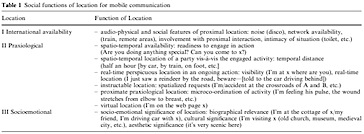I. Arminen. Social functions of location in mobile telephony. Personal Ubiquitous Computing, 10(5):319–323, 2006. [PDF]
——–
This paper describes a conversational analysis of mobile phone conversations. The author tried to understand why and how people communicate their location in phone calls. The study extends the study of Laurier and Weilenmann in that this study elaborate the way in which location features in mobile users’ communicative behavior.
The author finds five situations in which location is used in mobile conversations. The first is the interactional availability (registered in the author’s dataset 15% of the time), or the availability to discussing the content of the phone call; The second is when the communication of location has an importance in the ongoing activity (22% of the cases), like when a car driver has to ask direction to a remote speaker. Seemingly, location might assume importance during the call as part of the activity the parties are involved into (9%) and as a prompt for future activities (48%, the majority of situations registered). Finally, location can be communicated even if it does not have any relevance for the activity at hand. In this case the author say that it has a social relevance (6% of the cases).
One of the author’s main implication of this study lies in the fact that according to him, location is never considered in purely geographical terms. Location is made important by the activities in which the parties are involved. Particularly, joint activities make spatio-temporal patterns.

